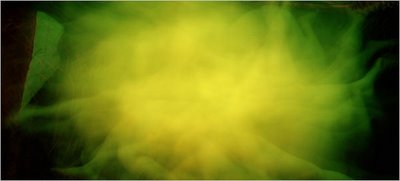Time Is the Most Surreal of All

Every day, hundreds of tourists snap photographs of a crowd- and car-jammed Times Square. The average picture takes — what? — 15 seconds to shoot? The same picture of the same place takes the Korean photographer Atta Kim eight hours. And his Times Square ends up with only an eerie trace of a human presence, like a deserted movie set.
Other pictures by Mr. Kim, who is making an outstanding New York solo debut in a show titled “Atta Kim: On-Air” at the International Center of Photography, have required less time. A photograph of a soccer game: two hours. Of a couple having sex: one hour. Still others go way beyond the eight-hour mark. “Monologue of Ice,” with its mysterious lozenge of pollen-yellow light hovering in the dark, is the product of a marathon 25-hour shoot.
And what is that picture of? A block of ice melting. Mr. Kim put the ice in a room and left the lens of his camera open to record the process of physical change as a solid form returned to fluid. Naturally, the transformation was slow. But who would have guessed that it would be so spectacularly photogenic — molten-looking and radiant?
Many of the large-format photographs in Mr. Kim’s show were made over time. His is an art of duration and of simultaneity. When he leaves his lens open for an hour on a couple making love, every movement made in that hour is in the picture, though condensed into an explosive blur. His view of Times Square leaves all the stationary elements — buildings and such — in crisp focus, but reduces traffic to a shimmering haze, a ghost of motion. Other famous New York intersections get the same treatment.
This technique is old. Early-19th-century pioneers of photography experimented with it. So do contemporary artists like Hiroshi Sugimoto, in his well-known shots of movie-house interiors taken while full-length films are in progress. What Mr. Kim brings to the tradition are new subjects — live-model Buddhist sculptures, for example — and dramatically extended temporal parameters, to create ever more complex compressions and layerings of time.
He has similarly pushed the boundaries in his extreme elaboration of a second traditional method of image-layering, one associated with double or multiple exposures. In several series of pictures Mr. Kim overlays different, semitransparent pictures of human figures, one on top of another, using digital editing. He piles up anywhere from a dozen to a hundred separate images to create a single composite picture, at once singular and multiple.
But while digitally savvy, Mr. Kim’s work is more distinctive for its ideas than for its technology. Born in South Korea in 1956, he earned a degree in mechanical engineering, but his interests were, and still are, literature and philosophy. He considers Heidegger’s speculations on time an important early influence, along with the teachings of the mystic G. I. Gurdjieff (which also shaped the work of the American photographer Minor White). Most important of all is Zen Buddhist thinking, although this thread has been fully apparent only in the last few years.
Mr. Kim’s earliest photographs were of patients in a Korean psychiatric hospital whom he shot during long, immersive, interactive sessions in the 1980’s. In the early 1990’s he created a series of cinematic performance-based pictures of nude models lying, as if asleep or dead, in desolate landscapes. The scenes looked like the aftermath of a catastrophe, but the bodies were meant to signify dormant new life.
His first New York appearance was in 2002 in the large group show “Translated Acts: Body and Performance Art From East Asia,” at the Queens Museum of Art. There he showed selections from “The Museum Project” (1995-2002), which remains his best-known body of work. (Excerpts from it are on view at Yossi Milo Gallery, 525 West 25th Street, Chelsea, through Aug. 25.)
That series centered on a single visual motif: one or more figures encased, as if on display, within a museum-style plexiglass vitrine. In the earliest pictures the figures were nude, often crouched in fetal position. Some of the vitrines were actually placed and shot in museums, others in natural settings or on city streets and in public buildings at off hours. The pictures that resulted were effective: quiet, miminalist, mildly surreal. They placed bare bodies where they would not otherwise be found, but also made the bodies as untouchably inorganic as antique sculptures in a gallery or expensive machines in a showroom.
Mr. Kim varied his basic format in several subseries to create what he referred to as his own private museum of cultural and emotional subjects. One series offered a compendium of Korean “types”: families, artists, workers and so on. Another was composed of erotic couples

<< Home